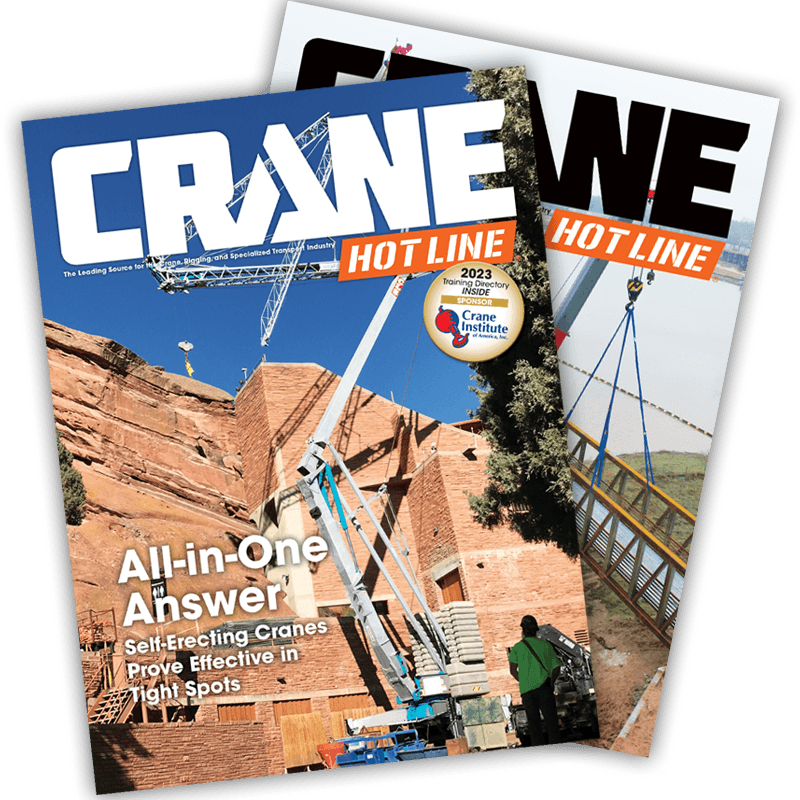Niche Play (Part 2)
August 23, 2006 • In a lift market that sees tens of thousands of new machines produced each and every year, it's interesting that the development of niche markets has been so slow. Although I see unique products in the market • many of them originally unveiled in

Enlarge Image
Image 1. ReachMaster FS 138 is ready to work in
Just about as specialized a lift as you'll find anywhere, Falcon products are one of only two lines sold in North America that are small enough to pass through a standard doorway and proceed to working heights in excess of 100 feet.
That's exactly the type of solution our FS 138 test unit brought to the table on the new $500 million city hall complex project in
Before I continue my analysis of this machine, I need to set the record straight. In Part One of this review, I mistakenly indicated that ReachMasters are produced in
Because ReachMaster was conducting a series of operator's training classes for the city's staff during my visit, the time that I was allowed to operate the 138-ft working height unit was brief. However, I had plenty of time to observe it in operation, listen in on the detailed training session, and then take a ride to the top of the rotunda. All of this, coupled with the opportunity to thoroughly look the unit over, allowed me more than ample information to come away from the review with a better understanding of how these units perform.
Image 2. Lower command center features a full array of electric and manual controls.
As with all aerial work platforms, the unit is commanded from either a lower control station which can be seen in Image 2 or from the fully proportional upper controls shown in Image 3. At the lower operation station, you have not only the electric controls but also manual controls. You can see them situated horizontally just below the blue and yellow box. These will operate the unit in emergency and over-ride situations. Rare over-ride situations may occur when an outrigger sensor reads that one outrigger has “gone light,” which causes the computer to shut the controls down. This happens when the computer cannot rationalize the proper way to move back into a “safe” position utilizing the electric controls. A wired remote is also a standard feature, which improves visibility of outrigger placement and can assist when positioning the unit in very tight applications.

Image 3. Upper controls are consistent with lower controls
Although this unit was equipped with the standard 375° non- continuous slewing, I should point out that 360° continuous boom rotation is an option. Another option that should be considered when making an acquisition of this nature is the auto set and leveling outrigger package • a feature this unit did not have but was possibly in line to get in a field retrofit. With this system, the outriggers can be auto-set and leveled at the push of a button from the upper or lower controls. With either the manual or auto-set mode, a slope of up to 8.5° can adjusted out. There are a variety of outrigger patterns. Not only can the length of each outrigger be varied, but the outrigger leg can also be swung horizontally so it is situated at different angles to the chassis. The narrowest is 14.27' X 14.27' with 21.65' X 21.65' being the widest position. I am told that in the mid-position, which is about a 19' X19' footprint, it can operate in about 80% of its work envelope. This all sounds complicated • and it could be • if it were not for the microprocessor that reads the outrigger footprints and enables the proper work envelope to match that pattern.

Image 4. Each of the jib's two 10-ft sections allows 180° of individual motion.
A great feature of the FS 138 is its double articulating jib (Image 4). Each section is about 10 ft in length and has a range of motion of about 180° vertically. What is really impressive is that they can work independently of each other. This standard feature even allows about 10 ft of negative reach capability. To add to this flexibility, the all-aluminum platform has 180° of rotation horizontally. If required, this lightweight platform can be easily removed. You can see the two pins in Image 5 that lock the platform into position.

Enlarge Image
It only stands to reason that you would want to utilize an investment like this as much as possible. Accordingly, these units can be fitted with a variety of supply lines to do just that. Note the large reels on either side of the boom, as shown in Image 6. These supply water, air, and 120VDC power to the platform.

Image 5. The lightweight basket can be easily removed to shorten length or exchange for smaller or larger sizes.
Most ReachMaster's run solely on DC power. What makes this particular unit unique is that it came equipped with an optional Lombardini diesel engine (Image 7). From here on out, it's important to note that all units with the diesel option will be equipped with a Kubota V155-T 4 cylinder diesel engine. That power plant is a 1.498 liter displacement and produces 36.7 hp @ 3,000 rpm
Enlarge Image
This is not a hybrid • that is to say where the engine powers a DC gen-set that in turn powers a DC pump motor. It is a true bi-energy setup where there are two individual and isolated power sources. Of course the IC system is intended for use outdoors, moving the unit long distances or in any situation where DC power is exhausted (and AC is not readily available for recharging).

Image 6. A variety of supply lines are offered to maximize application flexibility.
When it comes to transportation, moving a ReachMaster from one facility to another is actually much easier than you might think. Using the outriggers, all you have to do is raise the unit off the floor, which can be as high as a standard truck bed, and back your flatbed trailer or truck underneath. Once you are in proper position, lower the unit back down, and you're ready to secure it for travel.
Enlarge Image
It was more than 10 years ago when I was first exposed to a ReachMaster. Although similar in many ways, that product wasn't nearly as refined as the unit I saw on this visit. The design of this machine is so much more compatible with other aerial products in both operation and more importantly service areas. This is not to say that if you can service a more traditional boom lift that you will be able to jump right on this product and figure it out. By its very nature, it is a little more sophisticated than other products. Nevertheless, with the proper training and support, which ReachMaster has provided in the states for more than a decade, this shouldn't be a problem. It is exciting to see a product with such highly specialized capabilities and features become accepted in the

Image 7. Secondary power provided by a Lombardini diesel will make way for Kubota.


